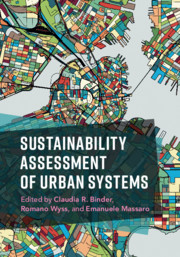Book contents
- Sustainability Assessment of Urban Systems
- Sustainability Assessment of Urban Systems
- Copyright page
- Contents
- Preface
- Acknowledgments
- Contributors
- General Introduction
- Part I Theoretical Background
- Part II Integrative Approaches for Sustainability Assessment
- Part III Perspectives on Urban Sustainability
- Part IV Focal Points of Urban Sustainability
- 15 Energy Challenges in Urban Systems
- 16 Sustainability Assessment of the Housing System: Exploring the Interplay between the Material and Social Systems
- 17 Sustainability Assessment of Urban Agriculture
- 18 Cities and Entropy: Assessing Urban Sustainability as a Problem of Coordination
- 19 Conceptualizing Urban Systems for Ecologic Sustainability Assessments: Case Study of the Stockholm Royal Seaport City District
- 20 A Study of Ride-Sharing Opportunities in the City of Santiago de Chile
- 21 Mosquito-Borne Disease and Human Mobility in Urban Environments
- Index
- References
15 - Energy Challenges in Urban Systems
from Part IV - Focal Points of Urban Sustainability
Published online by Cambridge University Press: 27 March 2020
- Sustainability Assessment of Urban Systems
- Sustainability Assessment of Urban Systems
- Copyright page
- Contents
- Preface
- Acknowledgments
- Contributors
- General Introduction
- Part I Theoretical Background
- Part II Integrative Approaches for Sustainability Assessment
- Part III Perspectives on Urban Sustainability
- Part IV Focal Points of Urban Sustainability
- 15 Energy Challenges in Urban Systems
- 16 Sustainability Assessment of the Housing System: Exploring the Interplay between the Material and Social Systems
- 17 Sustainability Assessment of Urban Agriculture
- 18 Cities and Entropy: Assessing Urban Sustainability as a Problem of Coordination
- 19 Conceptualizing Urban Systems for Ecologic Sustainability Assessments: Case Study of the Stockholm Royal Seaport City District
- 20 A Study of Ride-Sharing Opportunities in the City of Santiago de Chile
- 21 Mosquito-Borne Disease and Human Mobility in Urban Environments
- Index
- References
Summary
Supplying cities with sustainable energy is a major challenge as this requires deep transformation of the supply infrastructure in order to reduce energy waste and rely on local renewable energy sources. Building such a sustainable energy system requires a sound understanding of its entire supply chain and conversion steps from resources to final use so as to identify savings potential and prioritise actions. This chapter presents a systematic approach to assess the sustainability of energy systems that enables decision makers to build evidence-based strategies and take informed measures towards carbon neutral cities.
Keywords
- Type
- Chapter
- Information
- Sustainability Assessment of Urban Systems , pp. 353 - 383Publisher: Cambridge University PressPrint publication year: 2020



